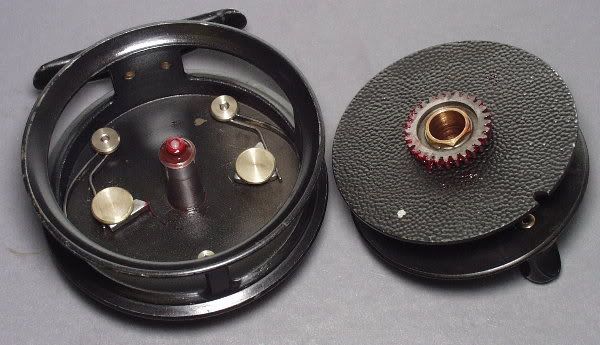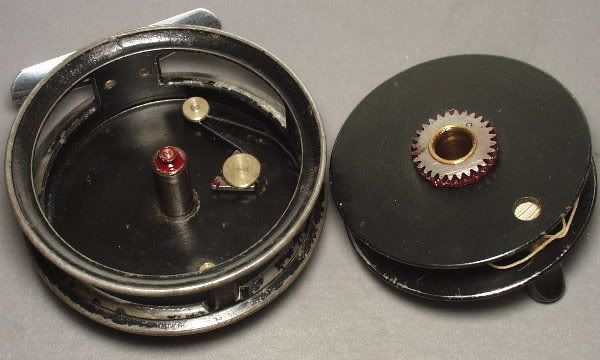|
I am about to show when a picture is worth 1000 words, because you have good illustrations above, and matching that set up takes care of it. But I'll try to explain how to determine on virtually any reel. A few have one entirely symetrical spring and pawl, so they are neutral as to winding direction without tinkering with the spring or pawl shape. But most, and any adjustable, have a built-in mechanical bias. and some give a choice of which spring and pawl to use. Anyway, ordinarily you want a light, noise-maker click only on wind, and a stiffer outgoing click through its range of adjustment. Here's how to identify the optimum position. First, look at the pawl tip that engages the gear. Some are evenly beveled, in which case it doesn't matter, but most have a "soft" edge side and a "sharp" edge side. Visualize how the pawl tip will meet the gear. The side that meets the gear most directly is the side the gear teeth should bear on when line is going out, for example, counterclockwise in RHW. In the wind direction (clockwise for RHW), the "soft" side of the pawl should bear on the gear teeth, giving less resistance. So now we know how the point of the pawl should be oriented according to our preferred winding direction. This takes care of the mechanical advantage of the pawl-tip to gear engagement by giving more resistance in one direction than the other. Merely turning the pawl over provides greater resistance in the opposite direction. That's half of it.
Second, we want to identify the correct mechanical advantage of the spring arrangement. Visualize the pawl as a an elongated triangle, with its point, "A" engaging the gear as described. Its top has two other "points" B and C and a flat or slightly convex line, B-C that rests against the leaf spring or pressure arm. At rest, the spring bears evenly against this line or at the apex of the convex curve. When the gear is rotated, it rocks the pawl such that point B or point C, according to the rotation direction, is lifted against resistance from the spring. We want the pawl installed on the correct post such that the spring provides greater resistance on pay than on wind. The spring has a mounting post and then extends out over the pawl and past its mounting post. The spring provides maximum resistance if it is lifted at a point inward of the pawl post, that is, closer to its mounting post. That's because the pawl point has less leverage against it, just like you did halfway up a see-saw with a big fat guy on the other end. If the pawl edge rocks outward of its post, it has more leverage against the spring (so feels lighter), just like you did when you moved toward the end of the seesaw. So determine which point, B or C, will be lifted in outgoing rotation. Install the pawl on the post that puts that point inward of the pawl mounting post. Thus, it will lift a shorter length of spring on pay (stiffer) and a longer length on wind (softer). Get it?
|




